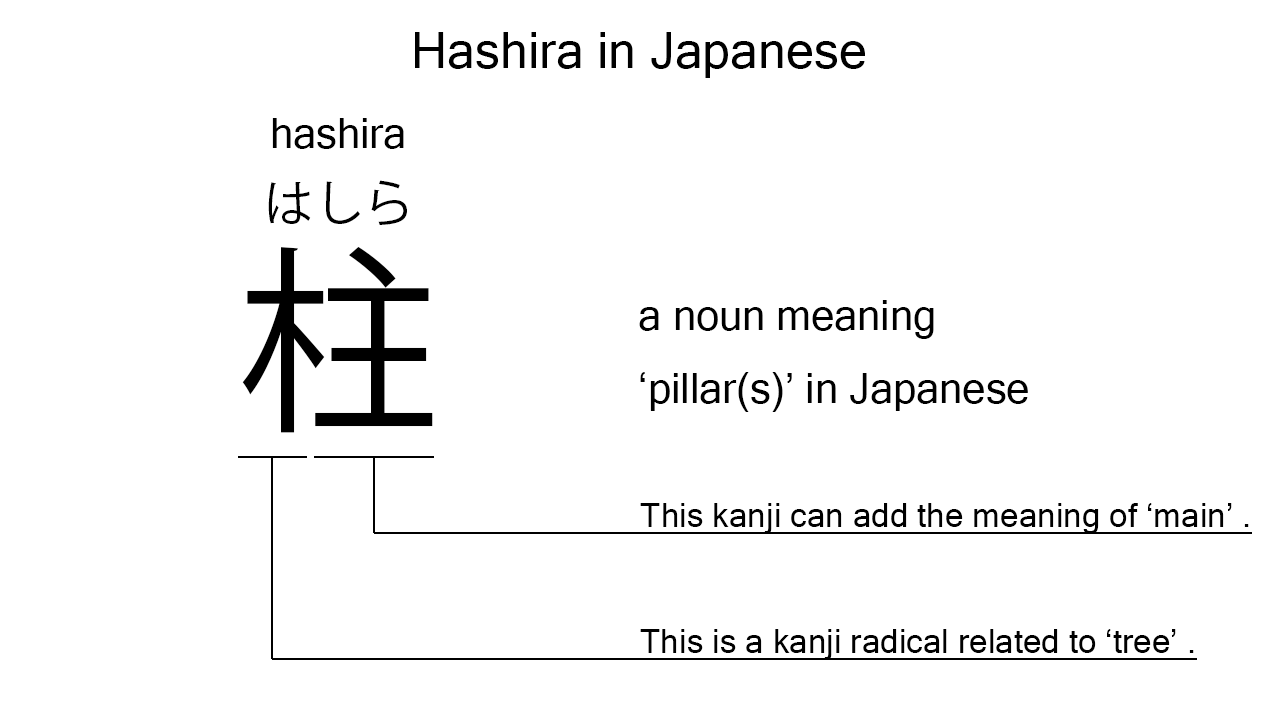What does “hashira” mean in Japanese?
Native speakers say “hashira” normally to mean ‘pillar’ in Japanese. Perhaps, some Japanese learners know this word as it is sometimes used in Japanese movies, manga, anime, and the like. In this blog post, however, I will explain this word in detail based on its kanji character. And also, I will explain how to use it through example sentences. My explanations would help Japanese learners understand “hashira” more clearly. Then, let’s get started!
Contents
Definition and meanings of “hashira”
Let me start with the definition and meanings of “hashira”.
- hashira – 柱 (はしら) : a noun meaning ‘pillar’ or ‘post’ in Japanese. This can also work as plural. Learn more about Japanese plural.
Normally, Japanese native speakers use this noun to refer to a pillar or pillars. It’s also worth mentioning here that they sometimes use this as a metaphor for someone playing a very important role in a group.
The definition and meanings are simple and clear. To understand this noun more clearly, however, let me explain its kanji character in detail.
What does “hashira” literally mean in Japanese?
The kanji character of “hashira” consists of the following two parts:
- 木 : a kanji radical related to ‘tree’. This is widely used in Japanese words related to plants.
- 主 : a kanji character often used to add the meaning of ‘main’, ‘major’, or such.
These two parts tell us that “hashira” literally means a ‘main tree’ in Japanese. This literal interpretation is not completely in line with the actual meanings, but still understandable, I think. Pillars are often made of big trees. In addition, someone playing a very important role in a group can be compared to a main tree in the woods.

When we meet new kanji characters, we should check their parts in detail to understand their meanings clearly and deeply. In many cases, kanji parts tell us a lot about the meanings of the characters they form. Actually, here, we could get the better understanding of “hashira” through the detailed kanji check above.
So far, I’ve explained the definition and meanings of “hashira” together with its kanji parts. Then, let me explain how to use it through the example sentences below.
Example #1: how to say “pillar” in Japanese
kore wa totemo futoi hashira desu – これはとても太い柱です (これはとてもふといはしらです)
This is a very thick pillar.
Below are the new words used in the example sentence.
- kore – これ : a demonstrative pronoun used to refer to something close to the speaker. In the example, this is used to mean ‘this’ in Japanese.
- wa – は : a binding particle working as a case marker or topic marker. In the example, this works after “kore” to make the subject in the sentence.
- totemo – とても : an adverb of degree meaning ‘very’, ‘much’, ‘so’, or such in Japanese. In the example, this works in front of “futoi” to emphasize its meaning.
- futoi – 太い (ふとい) : an i-adjective meaning ‘thick’ in Japanese. In the example, this works as a modifier in front of “hashira”.
- desu – です : an auxiliary verb used after a noun or adjective to make it polite. Probably, this is well known as a part of Japanese desu form. In the example, this is used after “totemo futoi hashira” to make it sound polite.
This is a typical usage of “hashira”. In this example, it works as a part of the noun phrase, “totemo futoi hashira”, which means ‘a very thick pillar’ in Japanese. When we want to refer to a pillar or pillars in Japanese, anyway, this noun is a very good option.
Example #2: another usage of “hashira”
boku ga kono kazoku no hashira desu – 僕がこの家族の柱です (ぼくがこのかぞくのはしらです)
I am a rock for this family.
Below are the new words used in the example sentence.
- boku – 僕 (ぼく) : a pronoun meaning ‘I’ in Japanese. This is used mainly by boys and young males.
- ga – が : a case particle used to make the subject word or the object word in a sentence. In the example, this is used after “boku” to make the subject in the sentence.
- kono – この : a determiner used before a noun which refers to something close to the speaker. In the example, this is used before “kazoku” to say “this family” in Japanese.
- kazoku – 家族 (かぞく) : a noun meaning ‘family’ in Japanese. This can also work as plural.
- no – の : a case particle joining two nouns or noun equivalent words. Normally, the first one can work as a modifier to describe the second. In the example, this works to join “kono kazoku” and “hashira”. The formed phrase literally means ‘a pillar of this family’ in Japanese. It has been translated as ‘a rock for this family’, though.
This is another typical usage of “hashira”. In this example, it works as a metaphor for someone playing a very important role in a group.
Summary
In this blog post, I’ve explained the definition and meanings of “hashira” in detail based on its kanji character. And also, I’ve explained how to use it through the example sentences. Let me summarize them as follows.
- hashira – 柱 (はしら) : a noun meaning ‘pillar’ or ‘post’ in Japanese. This can also work as plural. Japanese native speakers sometimes use this noun as a metaphor for someone playing a very important role in a group. These two kanji parts literally mean a ‘main tree’ in Japanese. This literal interpretation is not completely in line with the actual meanings, but still understandable, I think. Pillars are often made of big trees. In addition, someone playing a very important role in a group can be compared to a main tree in the woods.
Hope my explanations are understandable and helpful for Japanese learners.